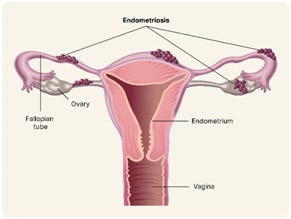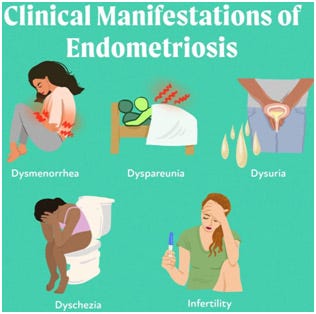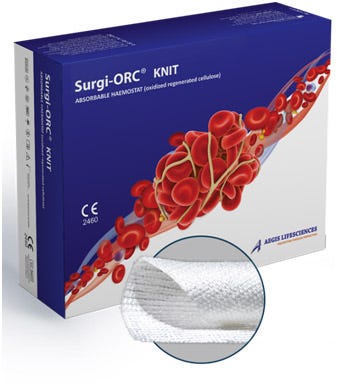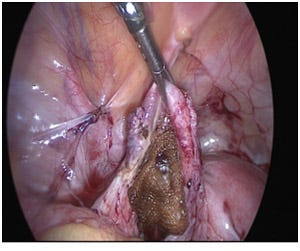Knitted Strip Haemostatic Agent: Minimizing Trauma in Laparoscopic Endometriosis Surgery
Endometriosis is a common, chronic, and estrogen-dependent condition that affects approximately 1 in 10 women of reproductive age. Among its many manifestations, ovarian endometriomas — often called chocolate cysts — pose a unique surgical challenge [1, 2]. These cysts, formed when endometrial-like tissue grows inside the ovaries, can lead to debilitating symptoms such as chronic pelvic pain, painful periods (dysmenorrhea), pain during intercourse (dyspareunia), and infertility[3].

Fig.1:Endometriosis: growth of endometrial-like tissue outside the uterus, affecting ovaries and fallopian tubes [2]
For many women, medical therapies like hormonal treatments provide insufficient relief, especially when fertility is a priority. In such cases, surgical intervention becomes essential. However, surgery for ovarian endometriomas requires a delicate balance: relieving symptoms while preserving ovarian function and fertility. This blog explores the latest surgical approaches for managing ovarian endometriomas and highlights how Surgi-ORC® Knit, an advanced hemostatic agent, is revolutionizing endometriosis surgery.

Fig.2: Symptoms of Endometriosis [3]
Understanding Surgical Options for Ovarian Endometriomas
Surgical management of ovarian endometriomas aims to remove or destroy the cyst while minimizing damage to healthy ovarian tissue. The choice of technique depends on the patient’s symptoms, fertility goals, and ovarian reserve. Below are the two primary approaches:
- Laparoscopic Cystectomy: The Standard of Care
Laparoscopic cystectomy is widely regarded as the most effective surgical method for treating ovarian endometriomas. This minimally invasive procedure involves carefully stripping the cyst wall from the ovarian cortex, preserving as much healthy tissue as possible. According to a comprehensive review by Hart et al., cystectomy outperforms other techniques like drainage or ablation in reducing cyst recurrence and improving spontaneous pregnancy rates post-surgery [4, 5].
The procedure typically uses the “stripping technique,” where the cyst wall is peeled away from surrounding ovarian tissue. To control bleeding, surgeons often rely on bipolar coagulation. While effective for haemostasis, this thermal method can inadvertently damage nearby ovarian follicles, reducing ovarian reserve — a critical concern for women seeking to preserve fertility.
- Cyst Wall Ablation
Cyst wall ablation is a less invasive option that uses energy-based tools — such as CO2 lasers, plasma energy, or bipolar electric currents — to destroy the cyst’s inner lining without removing the wall. This approach may be suitable for younger patients, those with smaller cysts, or women with already compromised ovarian reserve [6].
However, ablation has limitations. Traditional thermal methods, like monopolar or bipolar coagulation, can cause collateral damage to healthy ovarian tissue, further impairing fertility. As a result, ablation is often considered a secondary option when cystectomy isn’t feasible, particularly for fertility-focused cases.
The Challenge of Haemostasis in Ovarian Surgery
Effective haemostasis (bleeding control) is critical in ovarian endometrioma surgery, but thermal coagulation methods pose risks. Excessive heat can harm delicate ovarian tissue, leading to reduced follicle count and diminished fertility potential. This has driven the search for safer, fertility-preserving alternatives that achieve rapid haemostasis without compromising ovarian health.
Knitted Strip Haemostatic Agent (Surgi-ORC® Knit): A Safer Alternative
To overcome the limitations of thermal coagulation and minimize damage to ovarian tissue, surgeons are turning to topical haemostatic agents. One standout solution is the Surgi-ORC® Knit, a knitted strip haemostatic agent from the Surgi-ORC® family.
Surgi-ORC® Knit is a biodegradable, plant-based haemostatic agent composed of a sterile, absorbable knitted fabric produced through the controlled oxidation of regenerated cellulose. The fabric is white with a pale-yellow cast and has a faint caramel-like aroma. It is strong and can be sutured or cut without fraying.Upon contact with blood, Surgi-ORC® Knit forms a brownish or black gelatinous massthat accelerates clot formation, delivering rapid and effective localized haemostasis [7, 8].

Fig.3: Surgi-ORC® Knit (Knitted Strip Haemostatic Agent)
Key Features of Surgi-ORC® Knit
Surgi-ORC® Knit, a high-density variant of ORC, offers a host of benefits that make it ideal for gynaecologic procedures requiring delicate tissue handling.Its standout features include:
- Dense Knitted Structure:Surgi-ORC® Knit is three times denser than standard ORC, providing greater tensile strength and better adherence to tissue.
- Faster Haemostasis:Its high density allows for over 36% faster bleeding control compared to standard ORC, especially useful when precision is critical [7].
- Suture-Retention Capability:Unlike other topical agents, Surgi-ORC® Knit can be sutured in place without fraying, offering stability in dynamic surgical fields.
- Biocompatible and Absorbable: When applied correctly in minimal quantities, Surgi-ORC® Knit is absorbed within 7–14 days with minimal tissue reaction.
- Fertility-Preserving: Eliminates the need for thermal coagulation, minimizing ovarian tissue damage and preserving ovarian reserve.
Why Surgeons Choose Surgi-ORC® Knit
Gynaecologic surgeons value Surgi-ORC® Knit for its ability to simplify complex procedures while prioritizing patient outcomes. Its non-thermal approach minimizes trauma to ovarian tissue, ensuring better preservation of fertility. Additionally, its ease of application through small laparoscopic ports makes it a versatile tool for minimally invasive surgeries, reducing operative time and enhancing recovery.
Clinical Insight: A Case Report
A 33-year-old woman with a 4×3 cm ovarian endometriotic cyst underwent laparoscopic cystectomy at AIIMS, New Delhi. Instead of using bipolar coagulation, the surgeon applied Surgicel Nu-Knit (knitted strip haemostatic agent) to bleeding points. Key highlights:
- Easily introduced through a 5mm laparoscopic port
- Controlled bleeding without any use of thermal energy
- Preserved ovarian reserve
- Discharged just 7 hours post-surgery with an uneventful recovery
This case exemplifies how non-thermal haemostatic agents like Surgi-ORC® Knit can optimize outcomes in fertility-preserving gynaecologic procedures [9].

Fig.4: Surgicel Nu-Knit placed in cystectomy bed [9]
Conclusion
In the evolving landscape of gynaecologic surgery, preserving ovarian function is paramount. Surgi-ORC® Knit redefines fertility-preserving techniques by offering rapid haemostasis, minimal tissue trauma, and seamless integration into minimally invasive procedures. By eliminating the risks associated with thermal energy, this innovative, absorbable haemostatic solution empowers surgeons to achieve superior outcomes while safeguarding ovarian health.




Comments
Post a Comment